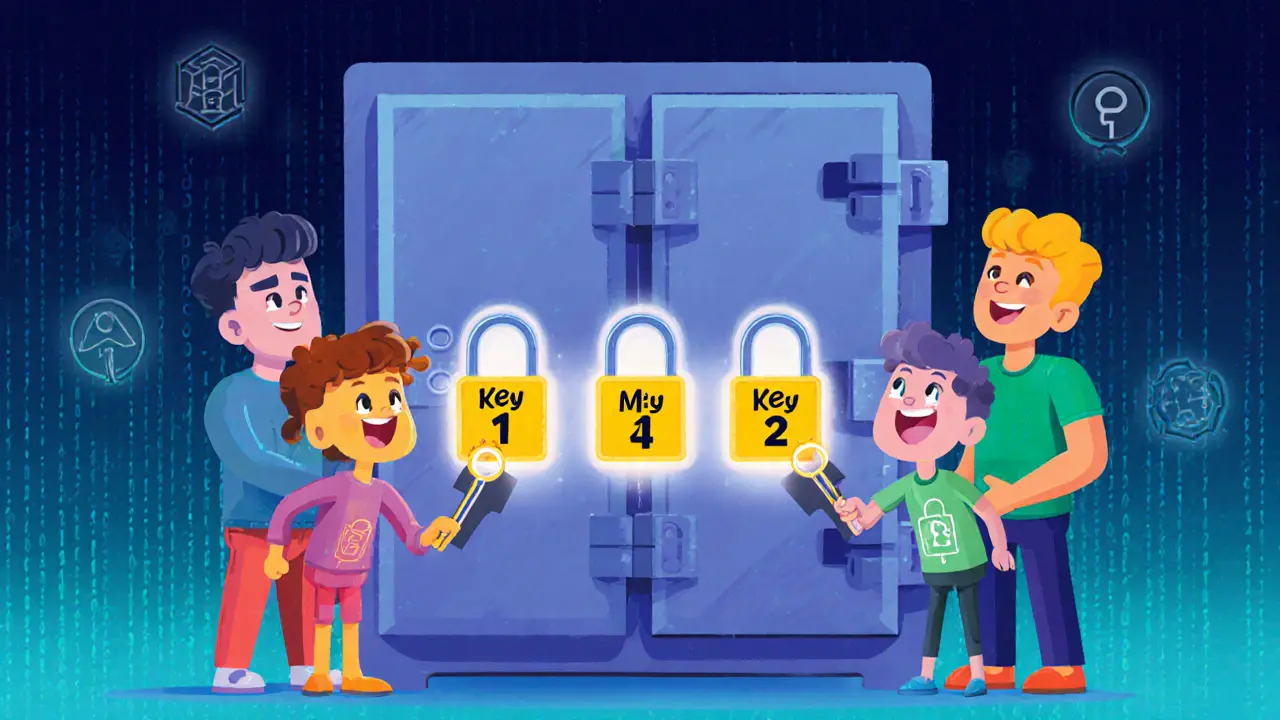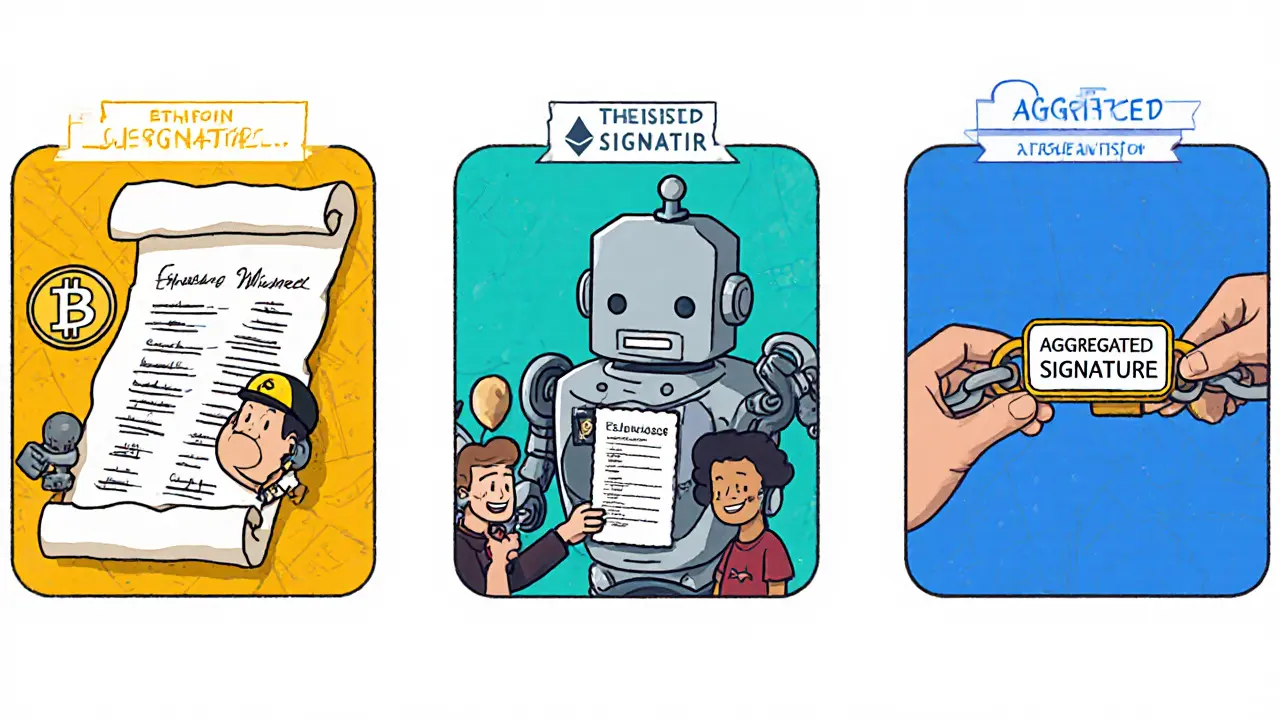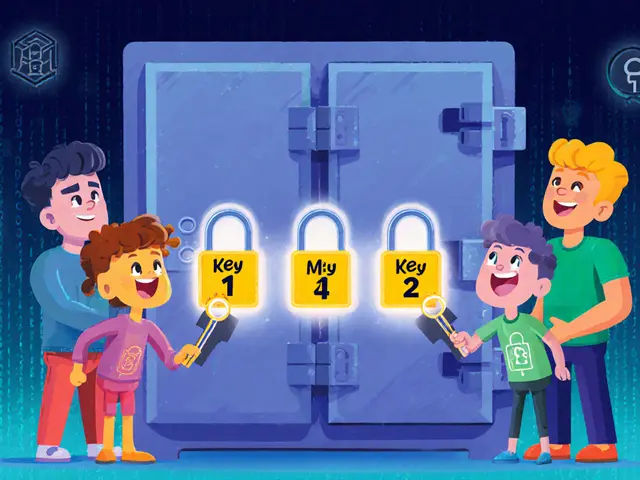The Future of Multi-Signature Technology in Blockchain Security

Multi-Signature Implementation Selector
Recommended Implementation
When you hear the term multi-signature technology is a security method that requires a predefined number of digital signatures (M) out of a possible set (N) before a blockchain transaction can be executed, you immediately picture a safer vault for digital money. Instead of a single key opening the door, you need a group of trusted parties to agree. That simple shift turns many of the biggest security headaches in crypto into manageable, auditable processes.
How Multi‑Signature Works Across Major Blockchains
At its core, the M‑of‑N rule is platform‑agnostic, but each blockchain builds the feature in its own way.
- Bitcoin offers native multi‑signature support via Pay‑to‑Script‑Hash (P2SH) addresses. The network verifies that the required number of signatures is present before confirming a transaction.
- Ethereum relies on smart contracts to emulate multi‑signature behavior. Contracts can store a list of authorized addresses and enforce thresholds before releasing funds.
- Threshold signature schemes generate a single compact signature that proves the required number of signers participated, reducing on‑chain data cost.
Below is a quick side‑by‑side look at the three most common implementations.
| Aspect | Bitcoin Native | Ethereum Smart Contract | Threshold Signatures |
|---|---|---|---|
| On‑chain footprint | Multiple signatures stored | Signature list stored in contract state | Single aggregated signature |
| Setup complexity | Key generation and address creation | Contract development and audit | Advanced cryptography, key ceremony |
| Flexibility | Fixed signer set | Dynamic signer changes via contract | Typically static after key ceremony |
| Typical use‑cases | Cold‑storage wallets, exchanges | DAO treasuries, DeFi governance | High‑frequency trading, cross‑chain bridges |
Real‑World Adoption: Who’s Using Multi‑Signature Today?
From individual crypto enthusiasts to global banks, the technology has found a home wherever assets need shared control.
- Financial institutions deploy multi‑signature wallets to meet regulatory “four‑eyes” rules and protect billions of euros in digital assets.
- Decentralized Autonomous Organizations (DAOs) use 3‑of‑5 or 4‑of‑7 setups to manage treasury funds, ensuring no single member can drain the vault.
- Major custodians like Coinbase Custody and Fireblocks embed native multi‑signature checks into their custody solutions, offering institutional clients an audit trail for every withdrawal.
- Platform integrations such as the Safe module on the Colony framework let on‑chain organizations add multi‑signature approval flows without writing custom contracts.

Why Multi‑Signature Beats Single‑Signature: Security Benefits
Think of a single private key as a single lock on a door. If that key is lost or stolen, the door opens to anyone. Multi‑signature adds multiple locks that all need to be turned together.
- External threat mitigation: An attacker would need to compromise several independent keys, dramatically raising the cost of theft.
- Internal fraud protection: No employee can unilaterally move funds, aligning blockchain practice with traditional corporate “two‑person” checks.
- Compliance alignment: Regulators in Europe and North America often require multi‑authorisation for large transfers; multi‑signature satisfies that requirement natively.
- Transparency: Every approved transaction leaves an on‑chain audit trail showing which signers participated.
Implementation Pain Points You Should Expect
Even great security comes with trade‑offs. Below are the most common hurdles.
- Key management overhead: Adding or removing a signer means re‑generating keys or updating contract state, which can be time‑consuming.
- Membership churn: In fast‑moving teams, every change may trigger a full key‑ceremony for threshold signatures, creating operational bottlenecks.
- Interoperability gaps: Bitcoin’s native P2SH scripts don’t translate directly to Ethereum’s contract‑based approach, complicating cross‑chain asset movements.
- Technical expertise required: Deploying a secure Ethereum multi‑sig contract often needs a professional audit, an expense smaller players may overlook.

Where the Technology Is Heading: Future Trends
Looking ahead, several developments promise to smooth out today’s rough edges.
- More efficient threshold signatures: Research from academic groups and core blockchain engineers is delivering schemes that cut on‑chain data by up to 90%, making high‑throughput use‑cases viable.
- Cross‑chain multi‑signature bridges: Projects like Polkadot’s XCMP and Cosmos’ IBC are experimenting with multi‑sig validation layers that span multiple ledgers, opening up truly decentralized finance pipelines.
- Automated governance workflows: Smart contracts are evolving to embed conditional approvals-e.g., “if market price drops 20% and three signers agree, execute a stop‑loss.”
- Integration with DeFi and NFTs: Multi‑signature vaults are being used to lock high‑value NFTs, while DeFi protocols adopt multi‑sig checkpoints for protocol upgrades.
- Standardized APIs: The emergence of the EIP‑3074 proposal (authenticator abstraction) could give developers a uniform way to invoke multi‑sig functions across EVM‑compatible chains.
Choosing the Right Multi‑Signature Model for Your Project
Not every solution fits every scenario. Use the quick decision guide below to pinpoint the best fit.
| Requirement | Best Fit | Why |
|---|---|---|
| Maximum on‑chain cost | Threshold signatures | Single aggregated proof reduces storage fees. |
| Frequent signer changes | Ethereum smart contract | Dynamic address list can be updated via governance. |
| High regulatory scrutiny | Bitcoin native multi‑sig | Well‑established audit trail, enforced by consensus. |
| Cross‑chain asset movement | Hybrid bridge with multi‑sig validation | Combines security of multi‑sig with interoperability layers. |
Frequently Asked Questions
Can I add a new signer without recreating all keys?
With native Bitcoin scripts you need to generate a new multisig address, which means a full key rotation. On Ethereum, a smart contract can expose an admin function to append or remove addresses, so you only need a contract transaction-still a deliberate on‑chain action, but no full key regeneration.
Are threshold signatures compatible with existing wallets?
Only a few wallets (e.g., Gnosis Safe on Ethereum, Rust‑based libraries for Schnorr‑based thresholds) currently support them out of the box. Most mainstream wallets still rely on traditional M‑of‑N scripts, so you may need a custom client or a custodial service.
Does multi‑signature protect against a compromised exchange?
If the exchange only holds the signing keys and you retain at least one key off‑site, the attacker can’t move funds without your participation. This is why many custodial solutions store a ‘watch‑only’ key in the exchange and keep the rest in a cold vault.
How does multi‑signature help DAOs with governance?
DAOs often need a minimum number of council members to approve a spend. By wiring the treasury to a multi‑sig contract, the proposal process becomes a coded rule: once the required signatures are on‑chain, funds move automatically, eliminating manual off‑chain tallying.
Is multi‑signature legal in regulated markets?
Regulators in the EU’s MiCA framework and the US’s FinCEN guidelines explicitly accept multi‑signature setups as “dual‑control” mechanisms, provided that the signers are verified and the process is auditable.
Bottom line: multi-signature technology isn’t a fad; it’s the backbone of secure, collaborative blockchain finance. Whether you’re a solo trader looking for a safer wallet or a Fortune‑500 bank building a custody platform, understanding the strengths, limits, and upcoming upgrades will let you pick the right model and stay ahead of emerging threats.


Darren Belisle
Wow, what a comprehensive guide! The way you broke down the three main implementations-Bitcoin native, Ethereum contract, and threshold signatures-is crystal clear, and it really helps newcomers see the trade‑offs. I especially love the decision table; it makes choosing a model feel almost like ordering a pizza, with toppings listed side by side! If you’re reading this and feeling a bit overwhelmed, remember that every project starts small, and you can always iterate later. Keep exploring, the future of multi‑sig is bright!!
Brian Lisk
The article does an excellent job of laying out the technical nuances of each multi‑signature approach, especially when it details how threshold signatures compress multiple approvals into a single on‑chain proof. By highlighting the on‑chain footprint differences, it equips developers with concrete metrics to evaluate cost‑sensitivity. Moreover, the inclusion of regulatory considerations aligns the discussion with real‑world compliance frameworks, which is often omitted in purely technical write‑ups. The decision matrix is another strong point; it translates abstract criteria into actionable guidance. Overall, this piece serves both engineers and compliance officers alike, bridging the gap that usually separates cryptographic theory from practical deployment.
Don Price
Reading this feels like watching the front‑page of a tech‑savvy conspiracy outlet – everything is presented as if the industry is merely an obedient servant of its own hype. While Bitcoin’s native multi‑sig is praised for “regulatory compliance,” one has to wonder who is really pulling the strings behind those audit trails. The “dynamic signer” story in Ethereum contracts could just be a convenient smokescreen for hidden backdoors, especially when governance tokens are involved. And those threshold signatures? They sound great until a secret consortium of key‑ceremony participants decides who gets to sign and who doesn’t. In short, the future of multi‑signature might be less about security and more about who controls the control.
Dawn van der Helm
Great read! 😊 The breakdown makes it so easy to pick the right tool for the job. 👍
Monafo Janssen
This helps a lot. I now see when to use Bitcoin native versus an Ethereum contract.
Michael Phillips
Interesting perspective on regulatory compliance; the audit trail detail is spot on.
Jason Duke
Whoa-talk about over‑hyping threshold signatures!!! They’re not a silver bullet, and the complexity can bite you back HARD!!!
Bryan Alexander
The evolution of multi‑signature technology reads like a saga of ambition, compromise, and relentless innovation. From the early days when Bitcoin’s P2SH scripts were the only option, we have marched toward sophisticated threshold schemes that compress dozens of approvals into a single cryptographic proof. This compression is not merely an engineering curiosity; it translates directly into lower gas costs, which is a decisive factor for high‑frequency trading platforms. Yet, the trade‑off is a steeper learning curve, demanding expertise in advanced cryptography and careful key‑ceremony management. Ethereum’s smart‑contract based multisig, on the other hand, offers unparalleled flexibility, allowing on‑chain governance policies to evolve without reshaping the underlying address format. The ability to add or remove signers via contract calls has unlocked a new wave of DAO treasuries, where community members collectively safeguard assets. However, this flexibility comes at the price of larger on‑chain footprints and the ever‑present risk of contract bugs, which have historically led to devastating fund losses. The industry’s response has been to rigorously audit contracts and to adopt proven libraries such as Gnosis Safe, but the risk cannot be entirely eliminated. Cross‑chain bridges introduce another layer of complexity, as they must reconcile differing signature verification models across disparate ecosystems. Hybrid solutions that embed multi‑sig verification into bridge contracts are emerging, promising secure asset transfers between, say, Polkadot and Cosmos, but they are still in experimental stages. Meanwhile, regulators across the EU and the United States have begun to codify “dual‑control” requirements, effectively endorsing multi‑signature as a compliance baseline for custodial services. This regulatory endorsement fuels institutional adoption, as banks and asset managers seek to meet stringent audit requirements. Yet, the sheer variety of implementations can cause confusion for auditors trying to verify that a given multi‑sig setup meets the prescribed standards. Future standards bodies may need to define interoperability layers that abstract away the underlying blockchain specifics. Moreover, recent academic research into lattice‑based threshold signatures promises to further reduce computational overhead, making them viable for low‑power devices and IoT integrations. As blockchain ecosystems mature, we can anticipate a convergence where the best aspects of each approach-Bitcoin’s robustness, Ethereum’s flexibility, and threshold schemes’ efficiency-coalesce into unified frameworks. In that converged future, developers will be able to pick the optimal security model with a single click, while end‑users enjoy seamless, secure transactions across any chain.
Patrick Gullion
While the long‑form epic paints an optimistic picture, let’s not forget that every added layer of abstraction introduces a new attack surface, and many projects will still opt for the simplest native multi‑sig to avoid that risk.
Jack Stiles
Totally agree-simplicity often wins. When you’re just starting out, a plain Bitcoin multisig is easier to audit than a custom bridge.
Ritu Srivastava
Regulators love the clear two‑person sign‑off, but they also demand that each signer be fully vetted-no shortcuts!
Liam Wells
In assessing the comparative merits of multi‑signature architectures, one must acknowledge the intrinsic tension between operational agility and cryptographic robustness. The native Bitcoin paradigm, albeit immutable, offers an unsurpassed auditability that aligns with statutory mandates. Conversely, Ethereum‑based contracts deliver a pliable framework wherein governance can evolve post‑deployment, albeit at the expense of increased attack vectors inherent to smart‑contract code. The emergent threshold signature constructs represent a synthesis of these dichotomous attributes, delivering on‑chain efficiency while preserving a degree of configurational rigidity. Thus, the prudent practitioner ought to calibrate the chosen schema against the projected transaction volume, regulatory exposure, and the maturity of the development team’s expertise.
Caleb Shepherd
Exactly-most developers underestimate the hidden costs of audits; a poorly written contract can cost more than the gas savings from a threshold scheme.
Ken Pritchard
Great discussion, everyone. If you’re unsure which path to take, start with a simple Bitcoin multi‑sig for cold storage, then experiment with an Ethereum contract for DAO‑style governance as your needs grow.
Richard Bocchinfuso
Sounds solid-just don’t over‑complicate things early on, keep it simple.
Mark Fewster
The key takeaway: balance security with usability; too much complexity can cripple adoption.
Sal Sam
From a systems‑architecture standpoint, the decision matrix effectively maps functional requirements to cryptographic primitives, ensuring alignment between business logic and consensus‑level enforcement.
Moses Yeo
One might say that the future of multi‑signature is a reflection of humanity’s own quest for shared trust-an endless dance between isolation and collaboration.